Firefighters play a vital role in the safety and security of our communities. This is especially true in the military. Military firefighters help keep military bases safe, and they can also help in emergencies and disasters. They can also assist civilian fire departments if they need help. But what branches of the military have firefighters? Let’s dive in and learn more about military firefighters.
History of Military Firefighting
Military firefighting has a long and storied history dating back to ancient civilizations. Military firefighting started a long time ago in the Roman Empire. Soldiers were in charge of fighting fires and keeping military camps and garrisons safe.
During the Napoleonic Wars, military firefighters protected their naval ships from fires. The history of military firefighting shows how it has changed over time to meet the needs of the military.

This military fire extinguisher manual pump wagon dates back to 1730 in Trondheim, and bears the emblem of Frederick IV of Denmark – a testament to the long history of firefighting and the bravery of those who serve.
Wolfmann, CC BY-SA 4.0, via Wikimedia Commons
The role of military firefighters
Military firefighters are responsible for numerous duties, including protecting military bases and installations, responding to emergencies and disasters, and providing fire prevention education and training. They are trained to handle various fire-related situations, including structure, aircraft, and wildland fires.
In addition to responding to fires and other emergencies, military firefighters may also be responsible for maintaining and servicing firefighting equipment, conducting inspections and risk assessments to identify potential fire hazards, and developing and implementing fire prevention programs. They also assist with disaster relief efforts within their military installations and the local community.
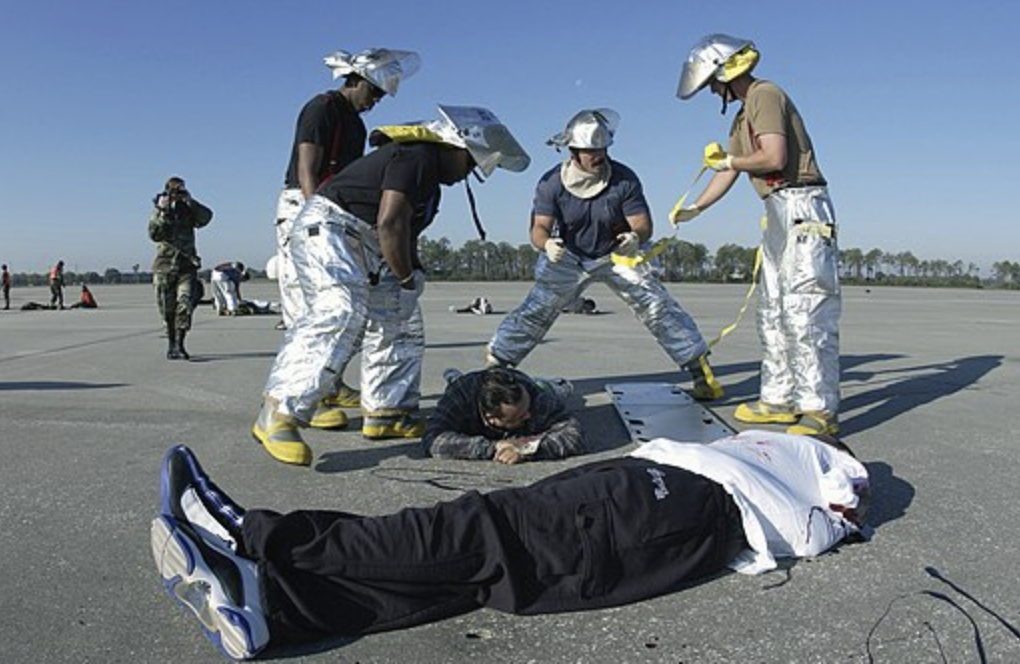
Ready for any emergency, the US Air Force Firefighters practice their life-saving skills during a Major Accident Response Exercise (MARE).
Military firefighters often work closely with other emergency response professionals, such as military police, emergency medical technicians, and hazardous materials specialists, to ensure they are prepared to handle any situation that may arise. They also receive extensive training in emergency response procedures, firefighting techniques, and other related skills.
Military firefighters in the Armed Forces
Every branch of the military has firefighters on staff. The responsibility of these firefighters is to respond to fire safety emergencies that may occur on installations or while in the field.
They must also be adept at providing first-response medical services and know how to deal with hazardous materials, such as fuel and ammunition. They maintain fire prevention and control equipment, inspect facilities for fire hazards, and perform inspections before and after an emergency.
Army firefighters
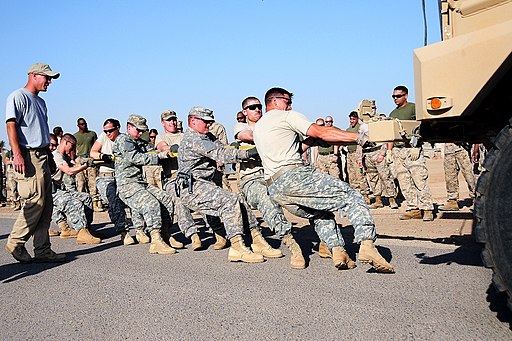
U.S. Army soldiers show off their strength and teamwork in the Firemen’s Challenge competition on Camp Ramadi, Iraq..
- In the Army, military firefighters are responsible for protecting Army installations and responding to fires and emergencies on the base. They also assist with disaster relief efforts within the Army and the local community.
- Like other military firefighters, Army firefighters receive extensive training in emergency response procedures, firefighting techniques, and other related skills.
- Army firefighters have a wide range of duties, one of which is responding to fires and other emergencies. In addition, they are responsible for maintaining firefighting equipment, conducting inspections to identify potential fire hazards. Training and educating others about fire safety and prevention is also a key aspect of their role.
Air Force firefighters
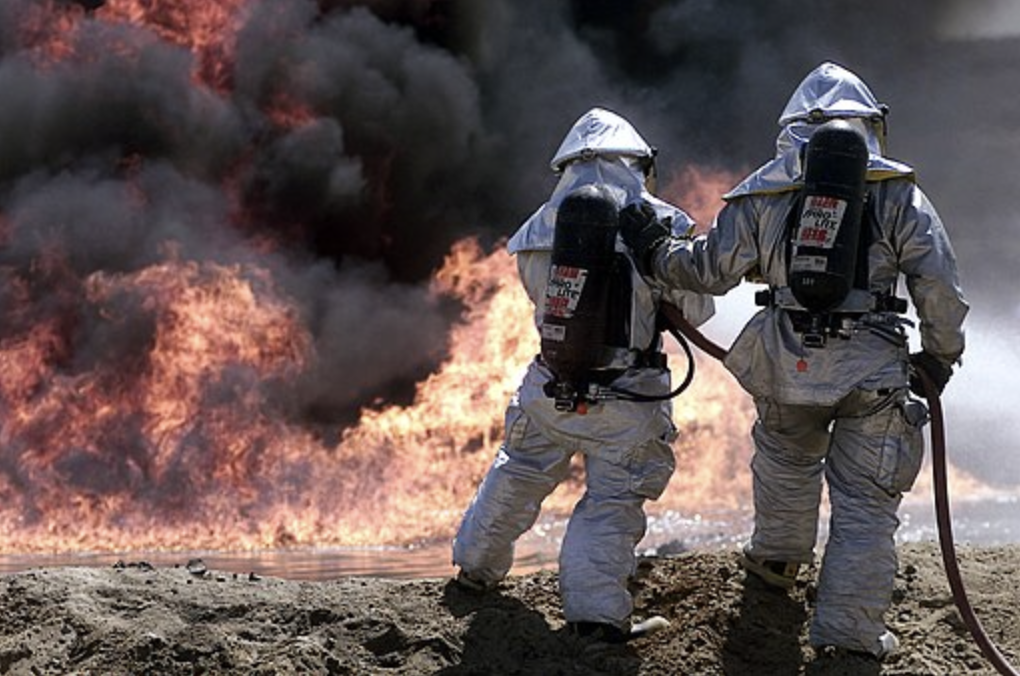
US Air Force firefighters bravely fighting the flames during Operation ENDURING FREEDOM at Camp Justice in Oman.
- Air Force Firefighters have an Air Force Specialty Code (AFSC) of 3E8X1. They are responsible for protecting Air Force bases and personnel from the risks of fires or other types of emergencies. They are also highly experienced in airborne operations, including aircraft rescue techniques.
- They are stationed within the United States and at Air Force bases overseas. The fire stations at Air Force bases are equipped with firefighting and rescue equipment and living quarters for the firefighters on duty.
- Air Force Firefighters provide essential support during large-scale emergencies such as natural disasters where air assets may be required for search & rescue operations or fire suppression activities near airports or other sensitive areas.
Navy firefighters
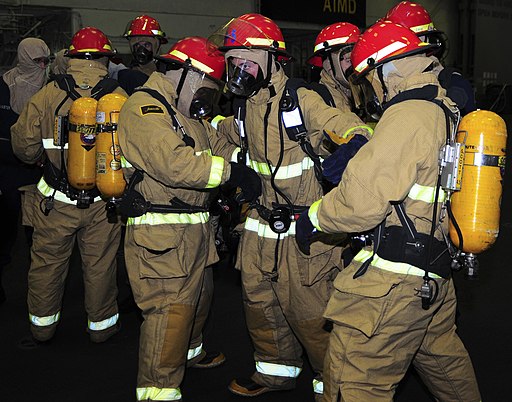
Teamwork makes the dream work. Sailors on the USS Bonhomme Richard work together to don their firefighter ensembles during a general quarters exercise.
- Navy firefighters ensure the safety of their sailors and their vessels. They are highly trained to respond quickly and efficiently in emergency response duties, providing medical attention, rescue operations, and fire suppression both on land and at sea.
- The work of a Navy firefighter requires a wide range of skills. They must know how to use specialized equipment to fight fires on board ships. They also have to be prepared for emergency medical treatments for wounded sailors and repair jobs for damaged equipment. Firefighters also understand hazardous materials like chemicals, biological agents, and radiation sources to protect their unit from those dangers in certain circumstances.
Marine Corps firefighters
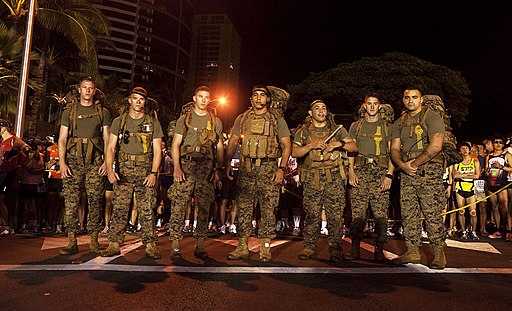
Marine firefighters put their endurance to the test as they hike the Honolulu Marathon, all while raising money for wounded warriors. Their dedication and determination knows no bounds.
- Marine Corps firefighters are responsible for protecting lives, property, and the environment from fire and related hazards within the Marine Corps. They are trained to respond to emergencies, including fires, hazardous material spills, medical emergencies, and natural disasters.
- Marine Corps firefighters also perform preventative maintenance on firefighting equipmentconduct inspections, and drills, and educate the community on fire prevention. They also receive specialized training in firefighting techniques, hazardous materials handling, and emergency medical care.
Training and qualifications
Military firefighters must meet rigorous physical and mental requirements to qualify. They must also possess strong communication skills, problem-solving abilities, and the ability to work well under pressure.
Physical requirements for firefighters may vary slightly depending on the military branch. Generally, candidates must be physically fit and able to perform physically demanding tasks such as carrying heavy equipment, climbing ladders, and working in challenging environments.
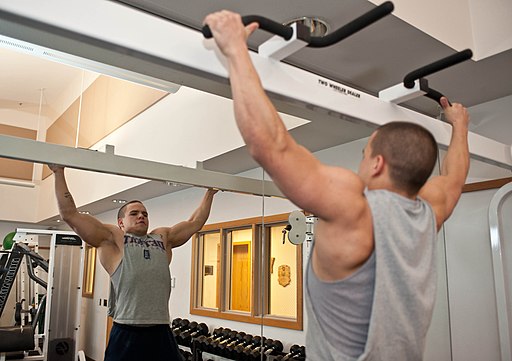
Exhibiting strength and determination, U.S. Air Force Senior Airman Stout shows off his skills during a workout.
Military firefighters must have strong mental and emotional capacities. They may be required to work under extreme stress in high-pressure situations and must be able to think clearly and make quick decisions to protect lives and property.
Military firefighters typically receive both classroom instruction and hands-on training as part of their education and technical training. The training may include courses in fire science, emergency medical procedures, hazardous materials response, and other related subjects, as well as training in the use of specialized equipment such as fire trucks, hoses, and breathing apparatus.
In addition to their technical training, military firefighters must also undergo rigorous military training to prepare them for the demands of military service. It includes military protocol, discipline, leadership, physical fitness, and combat readiness.
The Garland Fire Academy
The Louis F. Garland Department of Defense (DoD) Fire Academy is a training facility for military firefighters and civilian members who work for the Department of Defense. It is located at Goodfellow Air Force Base in San Angelo, Texas, and is operated by the Air Education and Training Command (AETC).
The Louis F. Garland (DoD) Fire Academy provides a wide range of training programs for military firefighters, including basic firefighting, advanced firefighting, hazardous materials response, and incident command. The academy also offers specialized training programs for officers and inspectors, as well as training in fire prevention and safety.
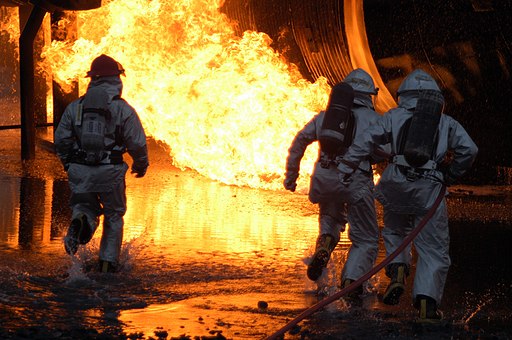
Two Aviation Boatswain’s Mate students put their training to the test as they bravely face a large-scale mock aircraft fire during their final evaluation at the Louis F. Garland Department of Defense (DoD) Fire Academy on Goodfellow Air Force Base in Texas.
The academy is named in honor of Louis F. Garland, a retired Air Force Chief Warrant Officer who served as a firefighter and fire chief for over 30 years. He was instrumental in establishing the DoD Fire Academy and was a leader in military firefighting.
The Garland Fire Academy is widely recognized as a leader in fire service training. It serves as a model for other fire academies around the world. Its programs are designed to provide students with the skills and knowledge they need to become effective and competent firefighters and to meet the challenges of protecting military facilities and personnel from fires and other emergencies.
All military branches have firefighters responsible for protecting military bases, equipment, and personnel from fires and other emergencies. They play a vital role in ensuring the safety and readiness of military operations and protecting the lives and property of military personnel and civilians on base.


